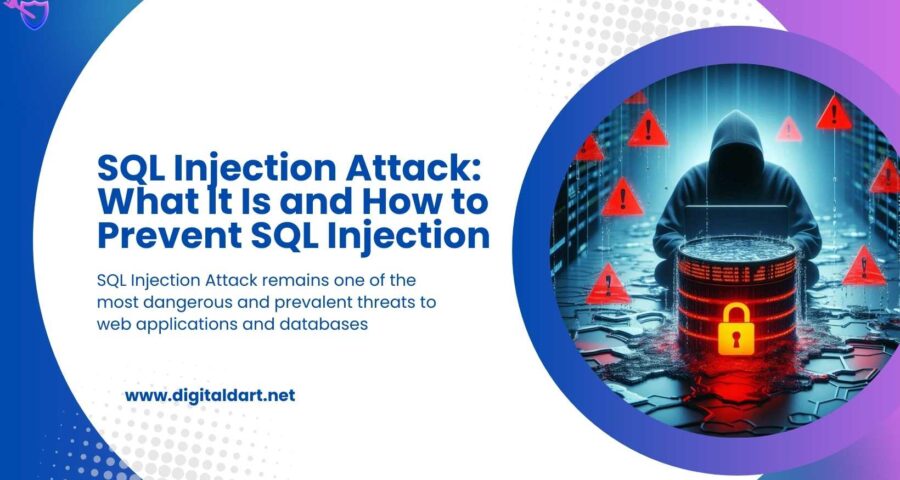Introduction
In today’s data-driven world, a SQL Injection Attack remains one of the most dangerous and prevalent threats to web applications and databases. By exploiting vulnerabilities in input handling, attackers can inject malicious SQL code to read, modify, or delete sensitive data. Understanding what a SQL Injection Attack is. and implementing robust prevention techniques, is critical for every developer, security engineer, and IT team striving to protect their digital assets.
What Is a SQL Injection Attack?
A SQL Injection Attack occurs when an attacker inserts or “injects” malicious SQL statements into an entry field for execution. This exploit takes advantage of applications that fail to properly validate or sanitize user-supplied input, allowing unauthorized commands to run against the database.
Types of SQL Injection Attacks
- In-Band SQL Injection
- Error-Based Leverages error messages returned by the database to uncover details about its structure.
- Union-Based Injection: Leverages the UNION SQL operator to combine attacker-supplied queries with legitimate ones.
- Inferential (Blind) SQL Injection
- Boolean-Based: Extracts information by issuing queries that produce true or false outcomes and observing the responses.
- Time-Based: Infers data by evaluating how long the database takes to respond.
- Out-of-Band SQL Injection
- Relies on features like DNS or HTTP callbacks to retrieve data when direct responses aren’t possible.
How Does a SQL Injection Attack Work?
Attackers typically follow these steps:
- Identify Vulnerable Input Fields
- Login forms, search bars, URL parameters, and HTTP headers often serve as entry points.
- Craft Malicious Payloads
- Simple tests (e.g., appending ‘ OR ‘1’=’1 to a query) can reveal weaknesses.
- More complex payloads exploit UNION statements, stacked queries, or database-specific features.
- Execute and Extract Data
- Once the payload executes, attackers may retrieve table names, column names, or even full records.
- In worst-case scenarios, they can escalate privileges, corrupt data, or execute administrative commands.
Common Vulnerabilities That Lead to SQL Injection Attack
- Unvalidated User Input: Accepting raw input without checks.
- Dynamic Query Construction: Building SQL statements by concatenating strings.
- Lack of Least Privilege: Using high-privileged database accounts for application queries.
- Verbose Error Messages: Exposing stack traces and SQL errors to end users.
Best Practices to Prevent SQL Injection Attack
Implementing defense in depth is the key to thwarting SQL Injection Attacks. Below are industry-standard techniques:
- Use Parameterized Queries and Prepared Statements
- Parameterized Queries: Isolates user input from SQL statements by passing it in as parameters rather than concatenating it into the query.
- Prepared Statements: Pre-compile SQL queries, ensuring user input cannot alter query structure.
- Example in Python with psycopg2
cursor.execute(
“SELECT * FROM users WHERE username = %s AND password = %s”,
(username, password)
)
- Employ Input Validation and Sanitization
- Whitelist Inputs: Define strict rules for allowable characters, lengths, and formats.
- Reject Suspicious Patterns: Block input containing SQL keywords (e.g., SELECT, UNION).
- Use Validation Libraries: Leverage well-tested frameworks to enforce schema constraints.
- Leverage Stored Procedures Carefully
- Stored procedures can encapsulate queries safely, if they avoid dynamic SQL.
- Always parameterize inputs within stored procedures to maintain separation between code and data.
- Adopt ORM Frameworks with Caution
- Object-Relational Mappers (ORMs) like Hibernate or Entity Framework auto-generate queries and help prevent injection.
- Review any raw-SQL or dynamic query features within your ORM layers.
- Enforce Least Privilege Access
- Dedicated Database Accounts: Assign each application component its own credentials.
- Minimal Permissions: Grant only the privileges needed (e.g., SELECT only for read-only services).
- Deploy a Web Application Firewall (WAF)
- Modern WAF solutions can recognize and block incoming requests that match known SQL injection signatures.
- Combine WAF rules with application-level checks for layered protection.
Testing and Monitoring for SQL Injection Attack
Automated Security Scanning
- Static Application Security Testing (SAST): Integrate code analyzers into your CI pipeline.
- Dynamic Application Security Testing (DAST): Scan running applications for injection vulnerabilities.
Manual Penetration Testing
- Expert Assessment: Retain cybersecurity specialists to conduct simulated attacks that mimic real-world threat scenarios.
- Threat Modeling: Update models whenever new endpoints or features are added.
Logging, Monitoring, and Alerting
- Detailed Logs: Record all failed and successful database queries, including parameters (with care to mask sensitive data).
- Anomaly Detection: Trigger alerts on spikes in errors, unusual query patterns, or unexpected data access.
Conclusion
A well-executed SQL Injection Attack can compromise your entire data infrastructure, leading to data breaches, service disruptions, and reputational damage. By applying parameterized queries, validating input, enforcing least privilege, and continuously testing your applications, you can dramatically reduce your exposure to this persistent threat.
For comprehensive protection that extends beyond your APIs and databases, covering network encryption, secure remote access, and threat shielding, partner with Digital Dart. As a leading VPN service provider, Digital Dart ensures that your data travels through encrypted tunnels, free from interception or tampering.
Ready to fortify your defenses?
Contact Digital Dart today for a free consultation and discover how our VPN solutions can safeguard your organization end to end.


Leave a Reply